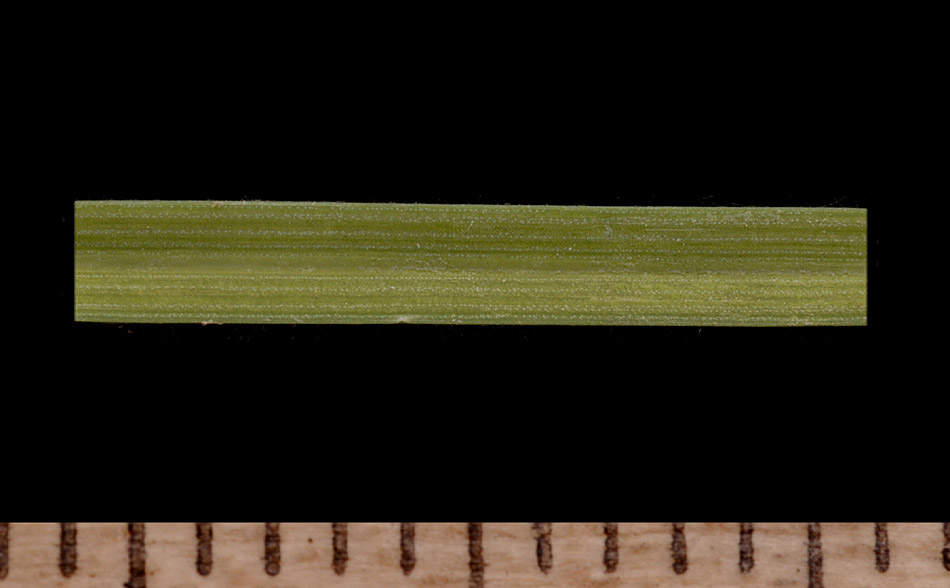 | Stigmas 2; achenes lenticular.
NOT [Stigmas 3; achenes three-sided, occasionally terete, though
their shape may be concealed by flattened perigynia.] |
 | Spikes 2 or more per culm, terminal
and lateral; spike bracts present on lateral spikes; lowest spike bracts
usually evident, often conspicuous, even in compact heads composed of
densely bunched and indistinguishable spikes (except in C. maritima,
C. chordorrhiza and C. microptera).
NOT [Spikes 1 per culm, terminal; spike bracts absent] |
 | Individual spikes distinguishable in
an open inflorescence, or indistinguishable in a compact head; spikes in
any one inflorescence alike in appearance due to their similar
composition (i.e. all are gynecandrous, androgynous, pistillate or
staminate), sessile. NOT [Individual spikes distinguishable in an open
inflorescence (densely bunched in C. bicolor); spikes in any one
inflorescence either markedly different in appearance (with terminal
spike staminate and lateral spikes pistillate), or subtly different in
appearance (with terminal spike gynecandrous and lateral spikes
pistillate), sessile or stalked.] |
 | Culms loosely to densely cespitose
(occasionally mat-forming rather than in discrete clumps); rhizomes, if
present, usually short with culms arising close together along them.
NOT [Culms single, or a few together, well-spaced along
conspicuous rhizomes or stolons.] |
 | Spikes gynecandrous, (terminal
spikes may be staminate in SK material of C. mackenziei;
pistillate or staminate spikes occur in Sect. Stellulatae, a
group distinguished by spongy tissue filling lower one-third to one-half
of the perigynium); if heads have indistinguishable spikes, the heads
are usually +/- as wide as they are long and usually widest in middle or
toward base. NOT [Spikes
androgynous, (lateral spikes occasionally pistillate in C. prairea);
if heads have indistinguishable spikes, the heads are usually oblong to
elongate in shape.] |
 | Lower 3 or 4 spike bracts usually
scale-like or bristle-like; if lowest is long and leaf-like, then it is
shorter than half the culm length or it appears to be an extension of
the culm to which inflorescence is attached laterally (as in C.
athrostachya); perigynia various.
NOT [Lower 3 or 4 spike bracts long, pale-green and leaf-like;
lowest bract 5-15 (20) cm long, usually half to fully as long as culm
below inflorescence; perigynia 5 mm long or longer, narrowly
lanceolate.] |
 | Perigynium distinctly wingless
though margins may be thickened as rounded or raised nerves; mature
achene filling width of perigynium body; perigynium base or wall
thickened by spongy tissue or cells; beak present or absent. NOT
[Perigynium margins flattened as a narrow or wide wing for all or part
of perigynium length (wing reduced to raised thickened nerve along body
in C. adusta); mature achene narrower than perigynium body; beak
present (though may be ill-defined); neither perigynium base nor
perigynium wall thickened with spongy tissue.] |
 | Perigynium wall thickened by spongy
cells toward base (usually only visible after cutting perigynium in
longitudinal section), surface puncticulate giving it a sparkly, beaded
look under magnification. NOT
[Bottom one-third to one-half of perigynium filled with spongy tissue
below achene; surface not punctate or puncticulate (conspicuously or
minutely beset with tiny pits).] |
 | Beak measurable, 0.25-1.0 mm long;
perigynia a brighter green with scales often tinged with shades of brown
(often colorless in C. canescens); spike shape variable;
perigynia 1-20 per spike. NOT
[Beak reduced to a nubbin too short to measure; perigynia muted green
with scales translucent to whitish giving the inflorescence a pale,
milky-green cast; spikes nearly round to short oblong; perigynia 3-10
(15 fna) per spike.] |
 | Lowest 1 or 2 spikes usually
separate to overlapping; if lowest spike remote then spikes longer than
wide, perigynia (5) 10-20 (30) per spike, terminal spike often V-shaped
with staminate flowers at base, beak ill-defined and about 0.25 mm long.
NOT [Lowest 1 or 2 spikes remote, about as wide as long,
few-flowered (fewer than 10 perigynia per spike); beak about 5 mm long.] |
 | Lower spikes separate to
overlapping, upper spikes either densely bunched and indistinguishable,
or overlapping but distinct; beak 0.5-1 mm long; number of spikes and
perigynia variable; rare species. NOT
[Lower spike occasionally remote, the rest regularly spaced at
decreasing intervals up culm from separate at base to densely
overlapping at tip; beak 0.25 mm long; spikes 4-8, usually 8-11 mm long,
3-5 mm wide, perigynia usually 10-20 per spike, common species of wet
habitats in most parts of Saskatchewan.] |
 | Spikes (2) 3-6, upper spikes
overlapping but distinguishable even at tip of inflorescence; beak 0.5
mm long; perigynia elliptic to elliptic-ovate (widest near middle and
tapering at both ends); plants of bogs, fens or salt (NaCl) flats.
NOT [Spikes 5-15, upper spikes densely bunched and
indistinguishable especially towards tip of inflorescence; beak about 1
mm long; perigynia ovate (widest near base); plants of moist, shaded
habitats.] |
 | Terminal spike with a V-shaped base
of staminate flowers for at least half its length, or staminate in some
specimens; plants of salt (NaCl) flats in two locations in east-central
SK. NOT [Terminal spike
scarcely V-shaped at base, if at all; plants of open bogs and fens.] |

